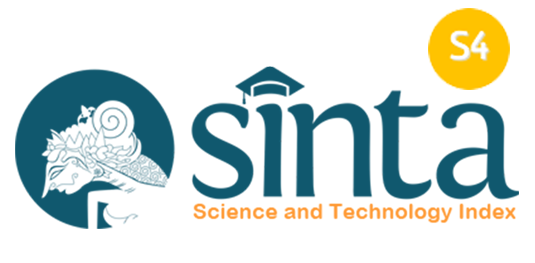Developing creative-problem-solving-based student worksheets for transformation geometry course
Abstract
Students’ reasoning ability in understanding the concepts in the Transformation Geometry course is still low. One of the causes is that there are no teaching materials, namely Student Worksheets that provide opportunities for students to be actively involved in creative learning processes; as a result, their reasoning skills are not well crafted. Therefore, it is necessary to develop a Student Worksheet that can strengthen students’ creative techniques and reasoning. The purpose of this study was to determine the feasibility of Student Worksheet products in terms of validity, practicality, and effectiveness. This research is an ADDIE development research whose stages comprise analysis, design, development, implementation, and evaluation. The instruments used in this study were validation sheets, student response questionnaires, learning outcomes, and learning implementation observation sheets. The results of this study were Creative Problem Solving (CPS) based Student Worksheet products in Geometry Transformation courses, and Student Worksheet eligibility, declared feasible in terms of (a) Validity; the worksheet validation results were in the very good category (4.36) (b) Practicality; the results of student response questionnaires to Student Worksheets were in a good category (31.16), and (c) effectiveness; the results of the test of student learning outcomes were in a good category (72%).
Keywords
Full Text:
PDFReferences
Alcid, A. S., Bandril, L. B. P., De Guzman, A. E., & Lopez, L. J. C. (2017). Analysis, design, development, implementation, and evaluation of a serious game designed to inform users on environmental issues. International Journal of Computing Sciences Research, 1(1), 11-23.
Cemil, I., Serdar, E., & Zea, G. (2017). The effect of mathematical worksheets based on multiple intelligences theory on the academic achievement of the students in the 4th grade primary school. Universal Journal of Educational, 5(8), 1372–1377.
Chi, M. T., Kang, S., & Yaghmourian, D. L. (2017). Why students learn more from dialogue-than monologue-videos: Analyses of peer interactions. Journal of the Learning Sciences, 26(1), 10-50.
De Villiers, M. D., & Njisane, R. M. (1987). The development of geometric thinking among black high school pupils in Kwazulu (Republic of South Africa). In Proceedings of the 11th Conference of the International Group for the Psychology of Mathematics Education (Vol. 3, pp. 117-123). Montreal: PME.
Guven, B. (2012). Using dynamic geometry software to improve eight grade students' understanding of transformation geometry. Australasian Journal of Educational Technology, 28(2), 364-382.
Fetherstonhaugh, T., & Treagust, D. F. (1992). Students' understanding of light and its properties: Teaching to engender conceptual change. Science Education, 76(6), 653-672.
Hourigan, M., & Leavy, A. M. (2017). Preservice primary teachers' geometric thinking: Is pre-tertiary mathematics education building sufficiently strong foundations?. The Teacher Educator, 52(4), 346-364.
Hmelo-Silver, C. E. (2004). Problem-based learning: What and how do students learn?. Educational psychology review, 16(3), 235-266.
Joko, S. (2016). The development of students worksheet using geogebra assisted problem-based learning and its effect on ability of mathematical discovery of junior high students. In Proceeding of 3rd International Conference on Research, Implementation and Education of Mathematics and Science Yogyakarta (p. 385). Khairun: Department of Mathematics and Science Education, University of Khairun.
Tung, K. Y. (2015). Pembelajaran dan perkembangan belajar (1st ed.). Jakarta: PT. Indeks.
Lestari, I. (2013). Pengembangan bahan ajar berbasis kompetensi sesuai dengan kurikulum tingkat satuan pendidikan. Padang: Akademia.
Mitchell, E., Kowalik, & Thomas, F. (1999). Creative problem solving (3rd ed.). London: Genigraphics Inc.
Nagy-Kondor, R. (2010). Spatial ability, descrptive geometry and DGS. Journal of Annales Mathematics Informatic, 37(3), 199–210.
Risnawati. (2008). Strategi pembelajaran matematika. Pekanbaru: Suska Press.
Sherard, W. H. (1981). “Why is geometry a basic skill?” The Mathematics Teacher, 19–21.
Sugiyono. (2017). Metode penelitian & pengembangan “research and development.” (S. Y. Suryandari, Ed.). Bandung: Alfabeta.
Suryawati, E., & Osman, K. (2017). Contextual learning: Innovative approach towards the development of students’ scientific attitude and natural science performance. Eurasia Journal of Mathematics, Science and Technology Education, 14(1), 61-76.
Suyitno, A. (1997). Dasar dan proses pembelajaran matematika I. Semarang: FMIPA UNNES.
Suyono, & Hariyanto. (2011). Belajar dan pembelajaran (teori dan konsep dasar). Bandung: Remaja Rosdakarya.
Tjeerd, & Nieveen, N. (Eds.). (2007). An introduction to educational design research. Netherlands: SLO Netherland Institute for Curriculum Development.
Trianto. (2010). Mendesain model pembelajaran inovatif-progresif (konsep, landasan, implementasinya pada kurikulum tingkat satuan pendidikan). Jakarta: Prenada Media Group.
Viberg, O., & Grönlund, Å. (2017). Understanding students’ learning practices: Challenges for design and integration of mobile technology into distance education. Learning, Media and Technology, 42(3), 357-377.
Widoyoko, S., & Eko, P. (2015). Evaluasi program pembelajaran panduan praktis bagi pendidik dan calon pendidik. Yogyakarta: Pustaka.
Zambak, V. S., & Tyminski, A. M. (2017). A case study on specialised content knowledge development with dynamic geometry software: The analysis of influential factors and technology beliefs of three pre-service middle grades mathematics teachers. Mathematics Teacher Education and Development, 19(1), 82-106.
Zulyadaini. (2017). Development of student worksheets based realistic mathematics education (RME). International Journal of Engineering Research and Development, 13(2), 1–14.
DOI: https://doi.org/10.18860/ijtlm.v1i1.5581
Refbacks
- There are currently no refbacks.
Copyright (c) 2020 International Journal on Teaching and Learning Mathematics

This work is licensed under a Creative Commons Attribution-NonCommercial-ShareAlike 4.0 International License.
Indexed by :
.png)
.jpg)
.png)

.jpg)



